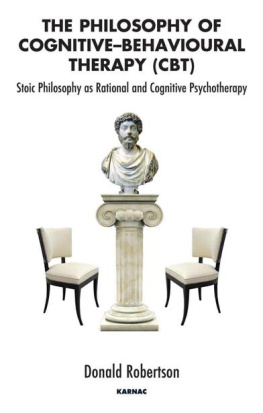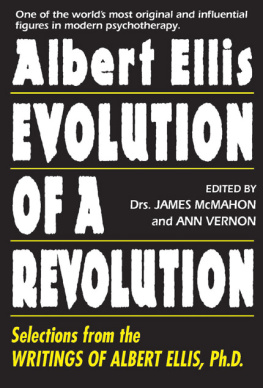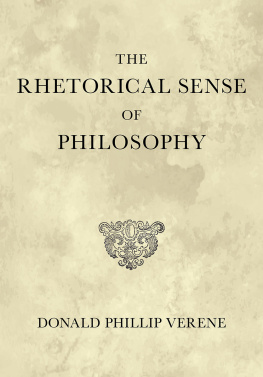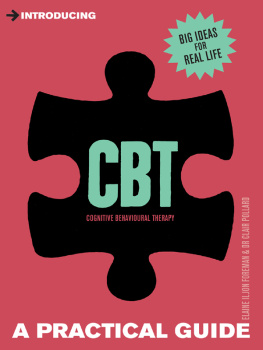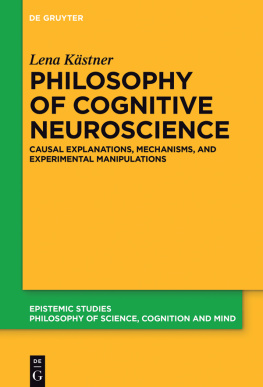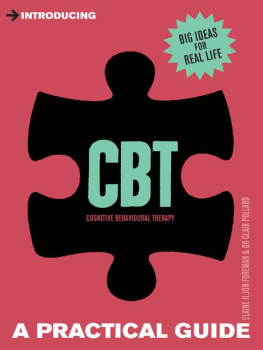CHAPTER TITLE I
THE PHILOSOPHY OF COGNITIVEBEHAVIOURAL THERAPY (CBT)
THE PHILOSOPHY OF COGNITIVEBEHAVIOURAL THERAPY (CBT)
Stoic Philosophy as Rational and Cognitive Psychotherapy Donald Robertson
First published 2010 by
Karnac Books Ltd
118 Finchley Road, London NW3 5HT
Copyright 2010 to Donald Robertson
The right of Donald Robertson to be identified as the author of this work has been asserted in accordance with 77 and 78 of the Copyright Design and Patents Act 1988.
All rights reserved. No part of this publication may be reproduced, stored in a retrieval system, or transmitted, in any form or by any means, electronic, mechanical, photocopying, recording, or otherwise, without the prior written permission of the publisher.
British Library Cataloguing in Publication Data
A C.I.P. for this book is available from the British Library
ISBN: 978 1 85575 756 1
Edited, designed and produced by The Studio Publishing Services Ltd www.publishingservicesuk.co.uk
e-mail: studio@publishingservicesuk.co.uk
Printed in Great Britain
www.karnacbooks.com
CONTENTS
ACKNOWLEDGEMENTS
ABOUT THE AUTHOR
FOREWORD by Prof. Stephen Palmer
INTRODUCTION: Philosophy and psychotherapy
PART I: PHILOSOPHY AND COGNITIVEBEHAVIOURAL THERAPY (CBT)
CHAPTER ONE
The philosophical origins of CBT
CHAPTER TWO
The beginning of modern cognitive therapy
CHAPTER THREE
A brief history of philosophical therapy
CHAPTER FOUR
Stoic philosophy and psychology
CHAPTER FIVE
Rational emotion in Stoicism and CBT
CHAPTER SIX
Stoicism and Elliss rational therapy (REBT)
PART II: THE STOIC ARMAMENTARIUM
CHAPTER SEVEN
Contemplation of the ideal sage
CHAPTER EIGHT
Stoic mindfulness of the here and now
CHAPTER NINE
Self-analysis and disputation
CHAPTER TEN
Autosuggestion, premeditation, and retrospection
CHAPTER ELEVEN
Premeditatio malorum and mental rehearsal
CHAPTER TWELVE
Stoic fatalism, determinism, and acceptance
CHAPTER THIRTEEN
The view from above and Stoic metaphysics
CONCLUSION
Fate guides the willing
APPENDIX I: An example of Stoic therapeutic regime
APPENDIX II: The View from Above script
REFERENCES
A CKNOWLEDGEMENTS
I would like to thank Socrates for being such a wise old sport and my wife Mandy for being so very un-Xanthippe-like in most respects, and for her love and support. Some credit is also due to Daisy Robertson, our cat, for agreeing to stay off my laptop long enough to avoid new Greek words being invented by the ritual movements involved in her making a cosy nest on the keyboard.
I am a world authority, let me be clear, on neither cognitive therapy nor classical philosophy, but I am in the fairly unusual position of knowing a decent amount about both. So I beg the indulgence of prospective critics, who might take offence at my having presumed to know it all, in an impossibly big subject. I hope it is not necessary, though, to extend the defence given by Epictetus: that you obviously do not know what you are talking about or you would have spotted all my other mistakes as well. I do need to thank Socrates, and the Stoics, though, for conceding their fallibility sufficiently to legitimize my own presumption in writing about virtues that I do not actually possess to any notable extent, except humility, of course, and possibly wisdom and courage, etc.
The publishers house referencing style has been used for most texts except the Stoic classics of Marcus Aurelius and Epictetus. In order to facilitate cross-referencing against the original texts and translations these have been referenced by citing the passages in question, rather than page numbers from translations, for example, as ( Discourses , 1.2.3). All quotations from Epictetus Discourses , Handbook , and Fragments are taken from Robin Hards translation unless otherwise specified (Epictetus, 1995). All quotations from Marcus Aureliuss Meditations are taken from Gregory Hays translation unless otherwise specified (Marcus Aurelius, 2003). Likewise, all quotations from Plato are taken from John M. Coopers edited Complete Works unless otherwise specified (Plato, 1997). Where necessary, certain translations have been quoted from other sources, as indicated in the text.
ABOUT THE AUTHOR
Donald Robertson is a psychotherapist and trainer who specializes in the treatment of anxiety and the use of cognitivebehavioural approaches and clinical hypnotherapy. He is the author of a number of articles on philosophy and psychotherapy in various therapy journals and magazines, and the editor of the book, The Discovery of Hypnosis , the complete writings of James Braid, the founder of hypnotherapy (2009). Donald has a degree in Mental Philosophy from Aberdeen University and a Masters in Psychoanalytic Studies from Sheffield Universitys Centre for Psychotherapeutic Studies; he is a UKCP registered psychotherapist.
Donalds background in academic philosophy has led him to appreciate the relationship between modern psychotherapy and ancient philosophy, a subject that he has frequently written about and lectured upon in training courses and professional conferences over the years. He originates from Ayr, on the west coast of Scotland, wham neer a toon surpasses for honest men and bonnie lasses , allegedly. He lives, however, in Englandalmost as good. He is kept company by his cat and his wife, called Daisy and Mandy, respectively.
FOREWORD
Prof. Stephen Palmer
Cognitive behavioural therapies are at the cutting edge of modern psychological therapeutic interventions. They are evidence based and, therefore, are underpinned by much research. In The United Kingdom (UK) the National Institute for Health and Clinical Excellence (NICE) has recommended cognitive behavioural therapy for depression and anxiety-related disorders such as panic attacks, obsessivecompulsive behaviour, body dysmorphic disorder, and post traumatic stress disorder (e.g., NICE, 2004, 2005, 2006, 2009). It is no surprise that this interests stakeholders wishing to provide cost-effective psychological therapies to their customers, that is, the public, in order to improve well-being and reduce financial expenditure. In the UK, the government has taken the next logical step and funded cognitivebehavioural therapy training as part of the Improving Access to Psychological Therapies (IAPT) programme. Stressed, depressed, and anxious citizens cost countries billions of pounds, according to the research data, and, understandably, reducing absenteeism from work due to psychological illness is an attractive target to focus on. An effective IAPT programme can benefit both the country and the individual.
Cognitivebehavioural therapy has become one of the main approaches for dealing effectively with a wide range of psychological disorders, and this has led to a large increase in the training of health professionals in this approach, especially within the UK. Key handbooks available to trainees, based on Dr Aaron Temkin Becks cognitive therapy (Beck, 1976), or Dr Albert Elliss rational emotive behaviour therapy (REBT) (Ellis, 1958), only briefly, if at all, cover the historical roots of these therapies. Ellis, in his publications, is often more explicit about the early origins of REBT in comparison to the books on cognitive and cognitivebehavioural therapy.
Yet, for many of us, something is missing from most of the literature. What has been needed is a book that covers the underlying philosophy of the cognitivebehavioural therapies in much greater depth. This book, on the Philosophy of CognitiveBehavioural Therapy , by Donald Robertson provides us with the missing link between the theory and the philosophy. This book takes us on a historical journey through millennia, and highlights the relevant philosophies and the ideas of the individual philosophers that can inform modern cognitivebehavioural therapies. This book also includes some therapeutic techniques that seem to be modern, yet were developed and written about many years ago. It is a fascinating read. The Philosophy of CognitiveBehavioural Therapy could be considered as either a prequel or a sequel to the standard textbook read by a trainee or experienced cognitivebehavioural or rational emotive practitioner who wants to understand these approaches to therapy within a historical framework.
Next page
